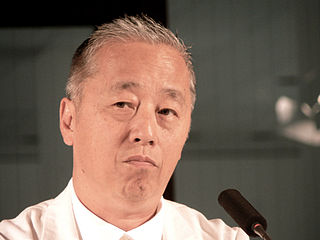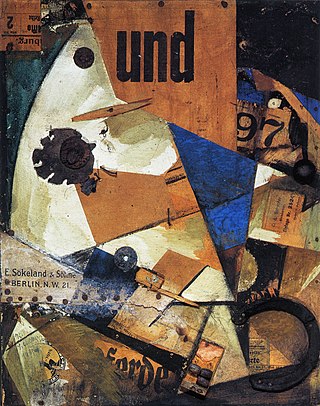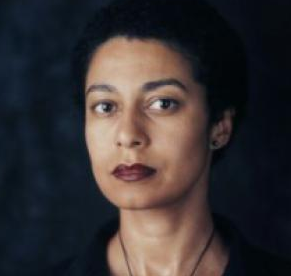Related Research Articles

Hiroshi Sugimoto is a Japanese photographer and architect. He leads the Tokyo-based architectural firm New Material Research Laboratory.
Barbara Kruger is an American conceptual artist and collagist associated with the Pictures Generation. She is most known for her collage style that consists of black-and-white photographs, overlaid with declarative captions, stated in white-on-red Futura Bold Oblique or Helvetica Ultra Condensed text. The phrases in her works often include pronouns such as "you", "your", "I", "we", and "they", addressing cultural constructions of power, identity, consumerism, and sexuality. Kruger's artistic mediums include photography, sculpture, graphic design, architecture, as well as video and audio installations.

Julie Mehretu is an Ethiopian American contemporary visual artist, known for her multi-layered paintings of abstracted landscapes on a large scale. Her paintings, drawings, and prints depict the cumulative effects of urban sociopolitical changes.

Isa Genzken is a German artist who lives and works in Berlin. Her primary media are sculpture and installation, using a wide variety of materials, including concrete, plaster, wood and textile. She also works with photography, video, film and collage.

Laurie Toby Edison is an internationally exhibited American artist, photographer, and visual activist. Much of Edison's photography is black-and-white fine art portraits. Their current project is Pandemic Shadows. Their lifelong commitment to social justice informs all their work. Their work has been exhibited in museums and galleries around the world, including New York City, Tokyo, Kyoto, Toronto, Boston, London, Shanghai, Los Angeles, Beijing, Seoul, Budapest, and San Francisco.
Dan Holdsworth is a British photographer who creates large-scale photographs and digital art characterized by the use of traditional techniques and unusually long exposure times, and by radical abstractions of geography. He has exhibited internationally including solo shows at BALTIC Centre for Contemporary Art, Gateshead, and Barbican Art Gallery, London; and group shows at Tate Britain, London, and Centre Pompidou, Paris. His work is held in collections including the Tate Collection, Saatchi Collection, and the Victoria and Albert Museum, London. He lives and works in Newcastle upon Tyne and London.
Maggie Taylor is an artist who works with digital images. She won the Santa Fe Center for Photography's Project Competition in 2004. Her work has been widely exhibited in the United States and Europe and is represented within the permanent collections of several galleries and museums.
Reginald Case was an American artist who made American Folk Art collages and Hollywood iconographic mixed-media assemblages and sculptures.

Sergei Sviatchenko is a Danish - Ukrainian architect, artist, photographer and curator. He is a representative of the Ukrainian New Wave, that arose in Ukraine up through the 1980s. Initiator and creative director of the Less Festival of Collage, Viborg and Just A Few Works. He has lived in Denmark since the 1990s. Sviatchenko graduated from Kharkov National University of Construction and Architecture in 1975, and in 1986 he studied a Ph.D. at the National Academy of Visual Arts and Architecture. Sviatchenko is the son of architect Evgenij Sviatchenko (1924-2004), who was professor of architecture and a member of the National Ukrainian Academy of Fine Arts and Architecture, and engineer Ninel Sviatchenko (1926-2000). In 1975 Sergei Sviatchenko completed his architectural studies at Kharkov National University of Construction and Architecture. Sergei Sviatchenko is especially oriented towards architecture's modern expressions, among these are Constructivism and the contemporary European Bauhaus movement. From his teacher, Professor Viktor Antonov, Sviatchenko was introduced to the film director Andrei Tarkovsky, and particularly his film Mirror from 1975 has left a thematic footprint in Sviatchenko's more recent collage art. After having worked as an architect for a number of architectural firms in Kharkov until 1983, Sviatchenko moved to Kyiv, where he successfully graduated the master's program at Kyiv National University of Construction and Architecture|Kiev National University of Construction and Architecture, having completed his Ph.D. dissertation "Means to Visual Information in Architecture". In the 1980s he was one of the founders of the Soviart Center for Contemporary Art (Soviart) in Kiev and co-organizer and curator of the first Ukrainian exhibitions of contemporary art ”Kiev-Tallinn” at Igor Sikorsky Kyiv Polytechnic Institute|Kiev Polytechnic Institute(1987), ”Kiev-Kaunas” (1988), the first joint exhibition by Soviet and American artists (1988) and curated the first Ukrainian exhibitions in Denmark: ”21 perceptions. Young Contemporary Ukrainian Artists” (1989), ”Ukrainian Art 1960-80” (1990), ”7 + 7” which was the first joint exhibition by Soviet and Danish artists (1990) and ”Flash. A New Generation of Ukrainian Art” (1990). At the end of 1990 Sviatchenko moved to Denmark with his wife Helena Sviatchenko having been awarded an art scholarship. In the same year he began to participate in solo and group exhibitions.
Appropriation in art is the use of pre-existing objects or images with little or no transformation applied to them. The use of appropriation has played a significant role in the history of the arts. In the visual arts, to appropriate means to properly adopt, borrow, recycle or sample aspects of human-made visual culture. Notable in this respect are the Readymades of Marcel Duchamp.

Collage is a technique of art creation, primarily used in the visual arts, but in music too, by which art results from an assemblage of different forms, thus creating a new whole.

Fatimah Tuggar is a interdisciplinary artist born in Nigeria and based in the United States. Tuggar uses collage and digital technology to create works that investigates dominant and linear narratives of gender, race, and technology. She is currently an Associate Professor of AI in the Arts: Art & Global Equity at the University of Florida in the United States.
Vera Lutter is a German artist based in New York City. She works with several forms of digital media, including photography, projections, and video-sound installations. Through a multitude of processes, Lutter's oeuvre focuses on light and its ability to articulate the passing time and movement within a tangible image.

Maud Sulter was a Scottish contemporary fine artist, photographer, writer, educator, feminist, cultural historian, and curator of Ghanaian heritage. She began her career as a writer and poet, becoming a visual artist not long afterwards. By the end of 1985 she had shown her artwork in three exhibitions and her first collection of poetry had been published. Sulter was known for her collaborations with other Black feminist scholars and activists, capturing the lives of Black people in Europe. She was a champion of the African-American sculptor Edmonia Lewis, and was fascinated by the Haitian-born French performer Jeanne Duval.

Lori Nix is an American photographer known for her photographs of handmade dioramas.
Anne Desmet is a British artist who specializes in wood engravings, linocuts and mixed media collages. She has had three major museum retrospectives, received over 30 international awards, and her work is in museum collections and publications worldwide.
Andrew Lambdin Moore is an American photographer and filmmaker known for large format color photographs of Detroit, Cuba, Russia, the American High Plains, and New York’s Times Square theaters. Moore’s photographs employ the formal vocabularies of architectural and landscape photography and the narrative approaches of documentary photography and journalism to detail remnants of societies in transition. His photographic essays have been published in monographs, anthologies, and magazines including The New York Times Magazine, Time, The New Yorker, National Geographic, Harper’s Magazine, The New York Review of Books, Fortune, Wired, and Art in America. Moore’s video work has been featured on PBS and MTV; his feature-length documentary about the artist Ray Johnson, “How to Draw a Bunny,” won the Special Jury Prize at the 2002 Sundance Film Festival. Moore teaches in the MFA Photography, Video and Related Media program at the School of Visual Arts in New York.

Amir Zaki is an American artist based in Southern California. He is best known for "hybridized" photographs using digital and analog technologies that explore the rhetoric of authenticity, vocabulary of documentary, and acts of looking and constructing images. His work often focuses on the iconography and landscape of Southern California, simultaneously celebrating the banal and vernacular and subverting its related mythology. Zaki has exhibited nationally and internationally, and been featured in shows at the Whitney Museum of American Art, Orange County Museum of Art, California Museum of Photography, and San Jose Museum of Art. His work is held in the public collections of the Los Angeles County Museum of Art, Hammer Museum, New Museum, and Whitney Museum, among many, and appears in the anthologies Vitamin Ph (2006), Photography is Magic and Both Sides of Sunset: Photographing Los Angeles (2015).
Isabelle Hayeur is a Canadian visual artist known for her photographs and experimental film. Hayeur’s works are inspired by a critical analysis of ecology and urbanity. Since the late 1990s, Hayeur has created public art commissions, photography books, video installations, and has participated in many solo and group exhibitions. Her artworks can be found in both national and international collections, including those of the National Gallery of Canada, the Vancouver Art Gallery, the Art Gallery of Ontario, the Art Gallery of Alberta (Edmonton), the Musée d’art contemporain de Montréal, the New Orleans Museum of Art and the Museum of Contemporary Photography in Chicago, and the Fonds national d’art contemporain in Paris.
References
- ↑ Welch, Matthew (2013). "Artistic remix: contemporary takes on timeless prints". Japanese Art Society of America. 34: 135.
- 1 2 Desmet, Anne (Summer 2008). "Old Masters reborn". Printmaking Today. 17 (2): 10.
- ↑ "Old world gets modern shake-up in Jersey artists digital collages". Bailiwick Express / Jersey News. 20 November 2018.
- ↑ n.a. "BBC: A Digital Picture of Britain". BBC. BBC. Retrieved 20 April 2020.
- ↑ Allchurch. "Settings 2003-2006". Emily Allchurch. Retrieved 23 April 2020.
- ↑ n.a. "Urban Chairoscuro statement" (PDF). Emily Allchurch. Retrieved 23 April 2020.
- ↑ Stuart, Keith (31 July 2008). "Emily Allchurch and the neoclassical level designer". The Guardian. Retrieved 8 March 2018.
- ↑ Welch (2013). Impressions (PDF). Japanese Art Society of America. pp. 123, 135, 138. Retrieved 21 April 2020.
- ↑ Allchurch. "Towers of Babel 2005-2018". Emily Allchurch. Retrieved 20 April 2020.
- ↑ n.a. "Babel Britain (after Verhaecht)". James Freeman Gallery. James Freeman Gallery. Retrieved 20 April 2020.
- ↑ "emily allchurch | Minneapolis Institute of Art" . Retrieved 8 March 2018.
- ↑ "ABOUT THE ARTIST – Emily Allchurch". www.emilyallchurch.com. Retrieved 8 March 2018.
- ↑ Art, Minneapolis Institute of (5 June 2014), Emily Allchurch | Tokyo Story , retrieved 8 March 2018
- ↑ "Emily Allchurch In the footsteps of a Master". Manchester Art Gallery. 2015.
- ↑ "Emily Allchurch: Visions of Architectural Fancy". Sir John Soane's Museum. 2018.